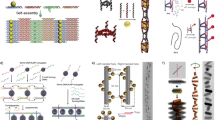Abstract
Nanoparticles represent versatile building blocks in material science and nanotechnology. Thereby, the defined assembly of nanostructures (13 and 56 nm in diameter, respectively) is of significant importance. Short DNA sequences can be bound to the nanoparticle surface thus enabling highly specific DNA hybridization-driven events that direct the formation of nanoparticle constructs.
In this paper, examples for the defined formation of gold nanoparticle constructs are demonstrated. In addition, gold–silver core-shell nanoparticles are introduced as further building blocks for the hybridization-controlled formation of nanoparticle constructs.









Similar content being viewed by others
References
Alivisatos AP, Johnsson KP, Peng X, Wilson TE, Loweth CJ, Bruchez MP Jr, Schultz PG (1996) Organization of “nanocrystal molecules” using DNA. Nature 382:609–611
Cao Y-W, Jin R, Mirkin CA (2001) DNA-modified core-shell Ag/Au nanoparticles. J Am Chem Soc 123:7961–7962
Csaki A, Maubach G, Born D, Reichert J, Fritzsche W (2002) DNA-based molecular nanotechnology. Single Mol 3:275–280
Csaki A, Kaplanek P, Möller R, Fritzsche W (2003) The optical detection of individual DNA-conjugated gold nanoparticle labels after metal enhancement. Nanotechnology 14:1262–1268
Daniel M-C, Astruc D (2004) Gold nanoparticles: assembly, supramolecular chemistry, quantum-size-related properties, and applications toward biology, catalysis, and nanotechnology. Chem Rev 104:293–346
Elghanian R, Stofhoff JJ, Mucic RC, Letsinger RL, Mirkin CA (1997) Selective colorimetric detection of polynucleotides based on the distance-dependent optical properties of gold nanoparticles. Science 277:1078–1081
Frens G (1973) Controlled nucleation for the regulation of the particle size in monodisperse gold suspensions. Nature: Phys Sci 241:20–22
Fritzsche W, Taton TA (2003) Metal nanoparticles as labels for heterogeneous, chip-based DNA detection. Nanotechnology 14:R63–R73
Huo F, Lytton-Jean AKR, Mirkin CA (2006) Asymmetric functionalization of nanoparticles based on thermally addressable DNA interconnects. Adv Mater 18:2304–2306
Jin R, Wu G, Li Z, Mirkin CA, Schatz GC (2003) What controls the melting properties of DNA-linked gold nanoparticle assemblies? J Am Chem Soc 125:1643–1654
Kreibig U, Vollmer M (1995) Optical Properties of Metal Clusters, Springer series in materials science, vol 25. Springer, Heidelberg
Li Z, Jin R, Mirkin CA, Letsinger RL (2002) Multiple thiol-anchor capped DNA-gold nanoparticle conjugates. Nucleic Acids Res 30:1558–1562
Link S, El-Sayed M (1999) Spectral properties and relaxation dynamics of surface plasmon electronic oscillations in gold and silver nanodots and nanorods. J Phys Chem B 103:8410–8426
Loweth CJ, Caldwell WB, Peng X, Alivisatos AP, Schultz PG (1999) DNA als Gerüst zur Bildung von Aggregaten aus Gold-Nanokristallen. Angew Chem 111:1925–1929
Mie G (1908) Beitrage zur Optik trüber Medien speziell kolloidaler Metallösungen. Ann Phys 25:377–445
Mirkin CA, Letsinger RL, Mucic RC, Storhoff JJ (1996) A DNA-based method for rationally assembling nanoparticles into macroscopic materials. Nature 382:607–609
Mock JJ, Barbic M, Smith DR, Schultz DA, Schultz S (2002) Shape effects in plasmon resonance of individual colloidal silver nanoparticles. J Chem Phys 116:6755–6759
Mucic RC, Storhoff JJ, Mirkin CA, Letsinger RL (1998) DNA-directed synthesis of binary nanoparticle network materials. J Am Chem Soc 120:12674–12675
Nykypanchuk D, Maye MM, van der Lelie D, Gang O (2008) DNA-guided crystallization of colloidal nanoparticles. Nature 451:549–552
Park SY, Lytton-Jean AKR, Lee B, Weigand S, Schatz GC, Mirkin CA (2008) DNA-programmable nanoparticle crystallization. Nature 451:553–556
Rasband WS, ImageJ, U. S. National Institutes of Health, Bethesda, Maryland, USA, http://rsb.info.nih.gov/ij/, 1997–2007
Raschke G, Kowarik S, Franzl T, Sönnichsen C, Klar TA, Feldmann J (2003) Biomolecular recognition based on single gold nanoparticle light scattering. Nano lett 3:935–938
Reynolds RA III, Mirkin CA, Letsinger RL (2000) Homogeneous, nanoparticle-based quantitative colorimetric detection of oligonucleotides. J Am Chem Soc 122:3795–3796
Schmid G (2003) Nanoparticles—From theory to applications. Wiley-VCH, Weinheim
Sönnichsen C, Reinhard BM, Liphardt J, Alivisatos AP (2005) A molecular ruler based on plasmon coupling of single gold and silver nanoparticles. Nat Biotechnol 23:741–745
Steinbrück A, Csaki A, Festag G, Fritzsche W (2006) Preparation and optical characterization of core-shell bimetal nanoparticles. Plasmonics 1:79–85
Steinbrück A, Csaki A, Ritter K, Leich M, Köhler JM, Fritzsche W (2008) Gold–silver and silver–silver nanoparticle constructs based on DNA hybridization of thiol- and amino-functionalized oligonucleotides. J Biophotonics 1:104–113.
Storhoff JJ, Elghanian R, Mucic RC, Mirkin CA, Letsinger RL (1998) One-pot colorimetric differentiation of polynucleotides with single base imperfections using gold nanoparticle probes. J Am Chem Soc 120:1959–1964
Taton TA, Lu G, Mirkin CA (2001) Two-color labeling of oligonucleotide arrays via size-selective scattering of nanoparticle probes. J Am Chem Soc 123:5164–5165
Tokareva I, Hutter E (2004) Hybridization of oligonucleotide-modified silver and gold nanoparticles in aqueous dispersions and on gold films. J Am Chem Soc 124:15784–15789
Turkevich J, Stevenson PL, Hillier J (1951) A study of the nucleation and growth processes in the synthesis of colloidal gold. Discuss Faraday Soc 11:55–75
Yao H, Yi C, Tzang C-H, Zhu J, Yang M (2007) DNA-directed self-assembly of gold nanoparticles into binary and ternary nanostructures. Nanotechnology 18:015102
Yguerabide J, Yguerabide E (1998a) Light-scattering submicroscopic particles as highly fluorescent analogs and their use as tracer labels in clinical and biological applications I. Theory. Anal Biochem 262:137–156
Yguerabide J, Yguerabide E (1998b) Light-scattering submicroscopic particles as highly fluorescent analogs and their use as tracer labels in clinical and biological applications II. Experimental characterization. Anal Biochem 262:157–176
Zanchet D, Micheel CM, Parak WJ, Gerion D, Alivisatos AP (2001) Electrophoretic isolation of discrete Au nanocrystal/DNA conjugates. Nano lett 1:32–35
Acknowledgments
We would like to acknowledge financial support from the European Union (project NUCAN; NMP-STREP 013775) and Katrin Buder (FLI Jena) for help with TEM measurements.
Author information
Authors and Affiliations
Corresponding author
Rights and permissions
About this article
Cite this article
Steinbrück, A., Csaki, A., Ritter, K. et al. Gold and gold–silver core-shell nanoparticle constructs with defined size based on DNA hybridization. J Nanopart Res 11, 623–633 (2009). https://doi.org/10.1007/s11051-008-9401-4
Received:
Accepted:
Published:
Issue Date:
DOI: https://doi.org/10.1007/s11051-008-9401-4




